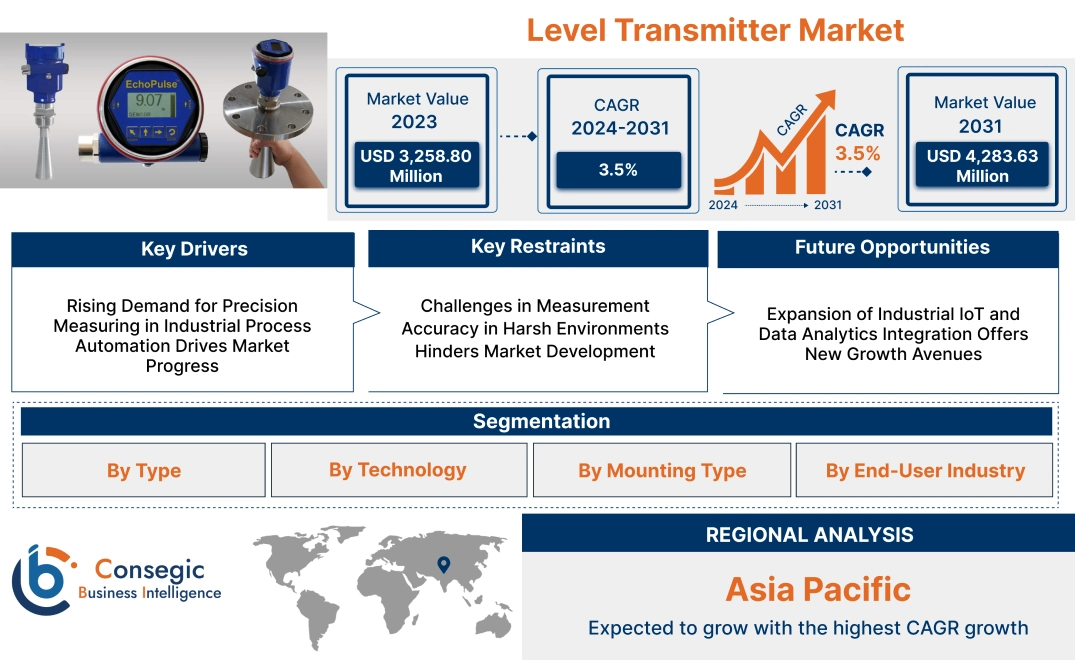- Summary
- Table Of Content
- Methodology
Level Transmitter Market Size:
Level Transmitter Market size is estimated to reach over USD 4,283.63 Million by 2031 from a value of USD 3,258.80 Million in 2023 and is projected to grow by USD 3,314.70 Million in 2024, growing at a CAGR of 3.5% from 2024 to 2031.
Level Transmitter Market Scope & Overview:
A level transmitter is an industrial device used to measure and monitor the level of liquids, solids, or gases within a container or system. These devices provide accurate and real-time measurements, ensuring precise monitoring for applications in industries such as oil and gas, water treatment, pharmaceuticals, and chemicals. Level transmitters are available in various types, including ultrasonic, radar, differential pressure, and magnetic level transmitters, each suited to specific operational requirements and environmental conditions.
These transmitters are engineered to withstand harsh environments, offering reliable performance in high-pressure, high-temperature, or corrosive conditions. Modern-level transmitters integrate advanced features such as digital displays, remote monitoring, and compatibility with industrial control systems, enhancing operational efficiency and safety.
End-users of level transmitters include process industries, manufacturing facilities, and utility providers that rely on precise level measurement to maintain system performance, ensure safety, and optimize resource utilization across diverse applications.
Level Transmitter Market Dynamics - (DRO) :
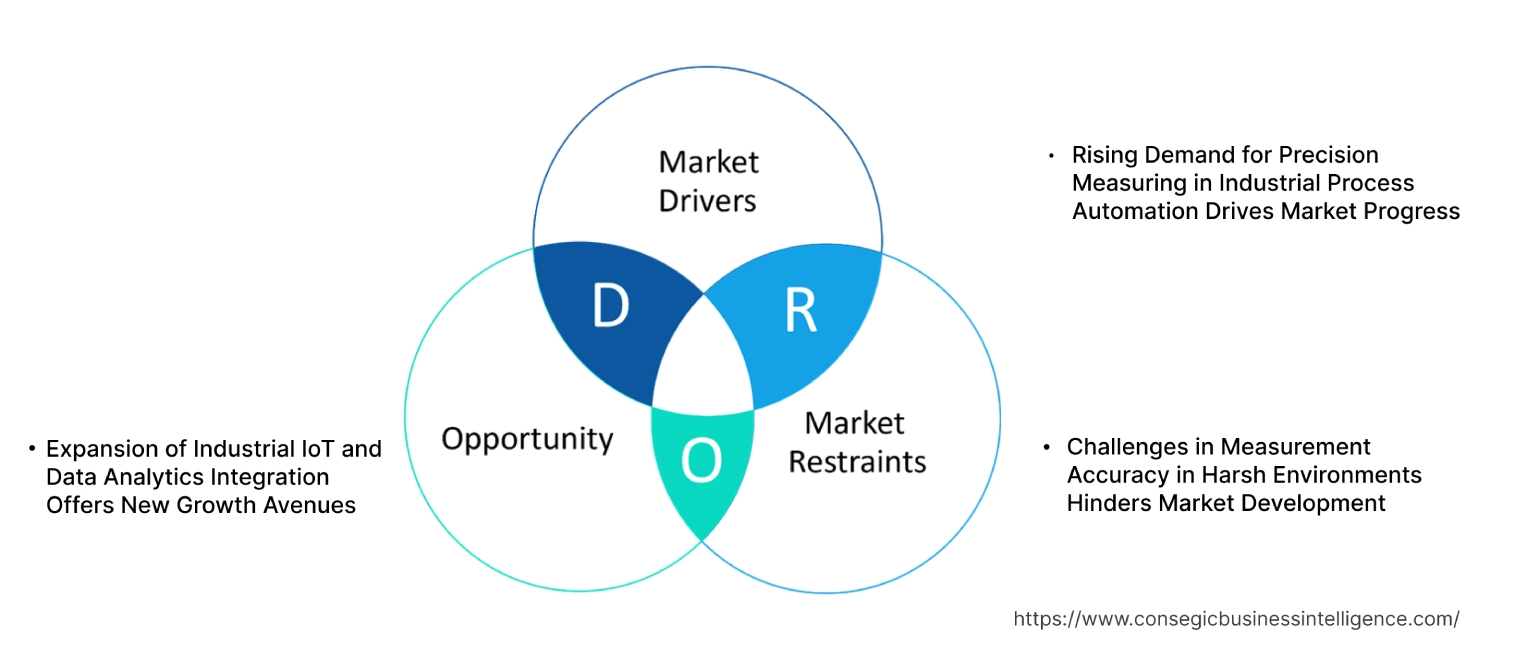
Key Drivers:
Rising Demand for Precision Measuring in Industrial Process Automation Drives Market Progress
The growing emphasis on precision and efficiency in industrial processes is a significant driver for the market. Industries such as oil & gas, chemicals, and water treatment require highly accurate systems to measure and control fluid levels, ensuring optimal operation and safety. Advanced technologies, including radar and ultrasonic measurement, provide superior accuracy and reliability compared to conventional methods. These systems are increasingly integrated into automated control systems, allowing real-time monitoring and adjustment, reducing errors, and enhancing productivity. Therefore, as per segmental trends analysis, the need for such precise systems is especially critical in industries with stringent safety and quality standards, further driving level transmitter market growth.
Key Restraints :
Challenges in Measurement Accuracy in Harsh Environments Hinders Market Development
Measurement systems face significant constraints in maintaining accuracy and reliability when operating in harsh environments. Conditions such as high temperatures, extreme pressures, and exposure to corrosive or abrasive substances compromise the performance of sensors and electronic components. These factors lead to frequent inaccuracies in readings, sensor degradation, and reduced equipment lifespan, which are particularly problematic in critical industries like oil & gas, chemicals, and mining. Inaccurate measurements in such conditions disrupt operational efficiency, lead to safety hazards, and increase downtime. The need for frequent recalibration, repairs, and part replacements further adds to operational costs. For industries with harsh environments, these limitations pose significant barriers to adopting advanced systems, particularly for cost-sensitive businesses, hampering the level transmitter market demand.
Future Opportunities :
Expansion of Industrial IoT and Data Analytics Integration Offers New Growth Avenues
The integration of Industrial IoT (IIoT) and data analytics is driving significant opportunities for advanced monitoring systems. IIoT-enabled solutions provide real-time data collection and remote monitoring capabilities, allowing industries to enhance operational efficiency and minimize downtime. These systems enable continuous tracking of fluid levels, temperature, and pressure, offering instant alerts for anomalies, which reduces the risk of system failures and improves process reliability. Data analytics further amplifies the value of IIoT by offering actionable insights derived from the collected data. Advanced analytics tools allow industries to optimize production workflows, forecast maintenance needs, and make data-driven decisions to improve productivity and resource utilization.
Cloud connectivity enhances scalability, enabling seamless data sharing across multiple facilities, making it ideal for large-scale industrial operations. Industries such as oil & gas, chemicals, and water treatment are increasingly adopting IIoT-driven solutions to meet the growing needs for automation, sustainability, and safety. The ability to integrate predictive analytics with smart systems is transforming industrial processes, making them more intelligent, efficient, and future-ready, thereby creating level transmitter market opportunities across various sectors.
Level Transmitter Market Segmental Analysis :
By Type:
Based on type, the market is segmented into Capacitive Level Transmitter, Radar Level Transmitter, Ultrasonic Level Transmitter, Differential Pressure Level Transmitter, Magnetostrictive Level Transmitter, and Guided Wave Radar Transmitter.
The Radar Level Transmitter segment held the largest revenue of the total level transmitter market share in 2023.
- Radar level transmitters are widely used in industries requiring high precision and reliability for measuring liquids, slurries, and solids.
- These transmitters operate effectively in harsh environments, including extreme temperatures, high pressures, and corrosive conditions.
- Advancements in radar technologies, such as frequency modulated continuous wave (FMCW), are enhancing measurement accuracy and range.
- As per segmental trends analysis, the dominance of this segment is driven by its versatility across applications such as oil & gas, chemicals, and water treatment, fueling level transmitter market expansion.
The Ultrasonic Level Transmitter segment is expected to register the fastest CAGR during the forecast period.
- Ultrasonic level transmitters are preferred for non-contact applications, ensuring high safety and hygiene standards, particularly in food & beverage and pharmaceuticals.
- These transmitters provide accurate measurements in open tanks and irregular surfaces, making them ideal for water & wastewater management.
- Their ease of installation and cost-effectiveness make ultrasonic transmitters suitable for small to medium-scale industries.
- As per level transmitter market analysis, the segment's rapid growth is attributed to the increasing adoption of sustainable water management practices and the need for precise fluid level monitoring.
By Technology:
Based on technology, the market is segmented into contact and non-contact.
The non-contact segment accounted for the largest revenue of the total level transmitter market share in 2023.
- Non-contact level transmitters, including radar and ultrasonic technologies, are favored for their ability to measure levels without physical interaction, ensuring minimal contamination risks.
- These systems are ideal for industries handling hazardous, corrosive, or high-pressure substances, such as chemicals and oil & gas.
- The integration of wireless and IoT communication technologies in non-contact transmitters enhances remote monitoring and operational efficiency.
- As per level transmitter market trends, the dominance of this segment reflects the growing preference for advanced, maintenance-free solutions in industries requiring high safety and hygiene standards.
The contact segment is expected to register the fastest CAGR during the forecast period.
- Contact level transmitters, such as capacitive and magnetostrictive types, are used in applications where direct measurement is necessary for high precision.
- These transmitters are widely adopted in energy and power generation facilities for monitoring fuel levels and other critical materials.
- Their ability to perform under extreme operating conditions makes them suitable for high-temperature and high-pressure environments.
- The rapid progress of this segment is supported by advancements in material engineering, improving durability and performance in demanding industrial settings and driving level transmitter market growth.
By Mounting Type:
Based on mounting type, the market is segmented into In-Tank, External, and Inline.
The in-tank segment held the largest market share of 52.38% in 2023.
- In-tank level transmitters are widely used for monitoring liquid levels in storage tanks, reactors, and vessels across various industries.
- These systems offer precise and real-time measurement, ensuring optimal inventory management and process efficiency.
- The dominance of this segment is attributed to its application in critical industries such as oil & gas and chemicals, where accurate tank-level monitoring is essential.
- Innovations in in-tank transmitters, such as guided wave radar systems, are further enhancing their capabilities and adoption, contributing to level transmitter market demand.
The external is expected to register the fastest CAGR during the forecast period.
- External level transmitters provide a non-invasive solution for measuring liquid levels, particularly in hazardous or pressurized containers.
- These systems are gaining traction in industries where retrofitting or modification of existing tanks is not feasible.
- The increasing adoption of external transmitters in water & wastewater management for monitoring open reservoirs supports the segment's growth.
- The analysis of segmental trends shows that the segment's rapid proliferation reflects the rising focus on safety and operational efficiency in industries handling volatile substances, driving level transmitter market expansion.
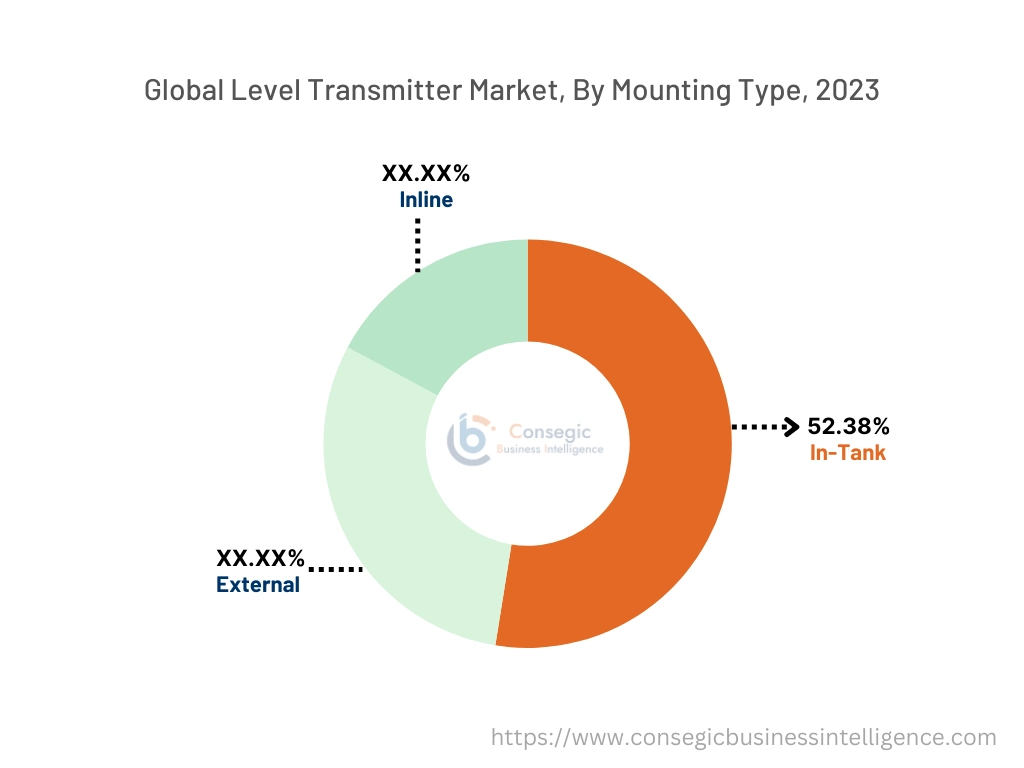
By End-Use:
Based on the end-user industry, the market is segmented into oil & gas, chemicals, water & wastewater, energy & power, food & beverage, and pharmaceuticals.
The oil & gas segment accounted for the largest revenue share in 2023.
- The oil & gas sector relies heavily on level transmitters for accurate monitoring of liquid hydrocarbons, slurries, and storage tanks.
- Stringent safety regulations and the need for precise level measurements in refineries and offshore platforms drive the adoption of advanced transmitters.
- The segment's dominance is further supported by the increasing adoption of radar and magnetostrictive technologies for high-pressure and high-temperature applications.
- Level transmitters are critical for ensuring operational efficiency and environmental compliance in the oil & gas sector, creating level transmitter market opportunities.
The water & wastewater segment is expected to register the fastest CAGR during the forecast period.
- Level transmitters play a vital role in monitoring water levels, flow rates, and tank storage in municipal and industrial water treatment facilities.
- The integration of smart sensors and IoT in water management systems enhances real-time monitoring and data analysis capabilities.
- The segment's rapid progress is driven by global initiatives to improve water conservation, reduce wastage, and modernize wastewater treatment facilities.
- As per level transmitter market trends, increasing investments in sustainable water infrastructure further boost the adoption of level transmitters in this segment.
Regional Analysis:
The regions covered are North America, Europe, Asia Pacific, the Middle East and Africa, and Latin America.
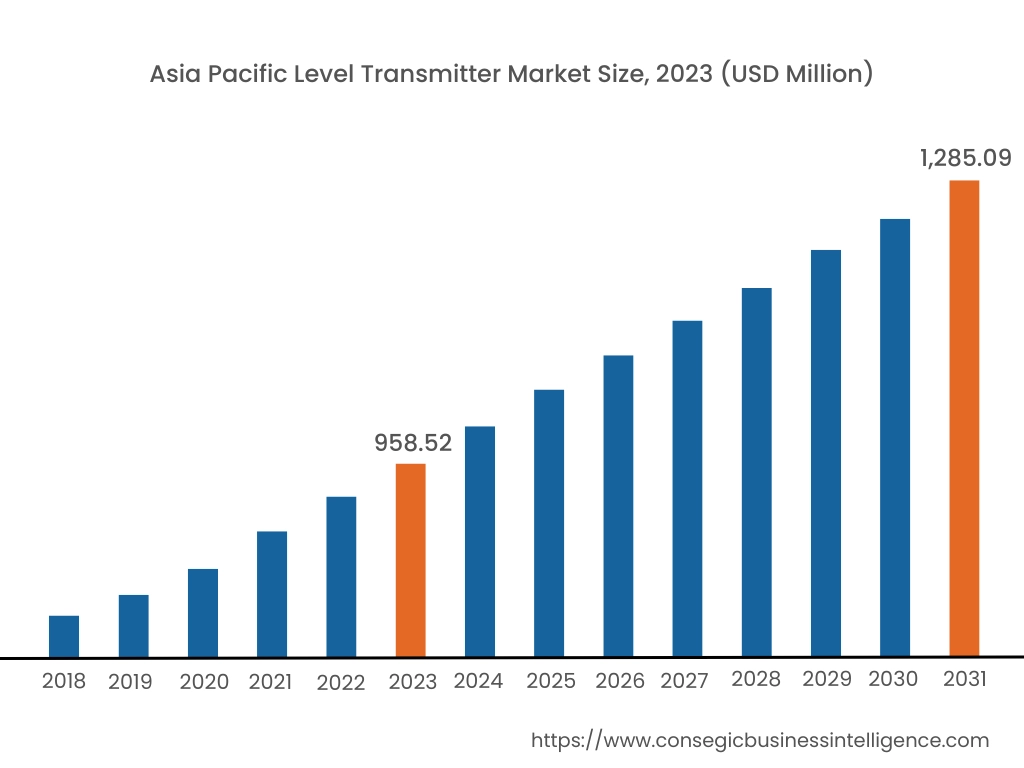
Asia Pacific region was valued at USD 958.52 Million in 2023. Moreover, it is projected to grow by USD 976.40 Million in 2024 and reach over USD 1,285.09 Million by 2031. Out of these, China accounted for the largest share of 41.4% in 2023. Asia-Pacific is witnessing the fastest growth in the level transmitter market, driven by rapid industrialization and urbanization in countries like China, India, and Japan. The region has become a global hub for manufacturing, with a strong emphasis on process industries such as oil and gas, chemicals, and water treatment. As per the level transmitter market analysis, the increasing investments in industrial automation and the extension of manufacturing facilities are further propelling market growth.
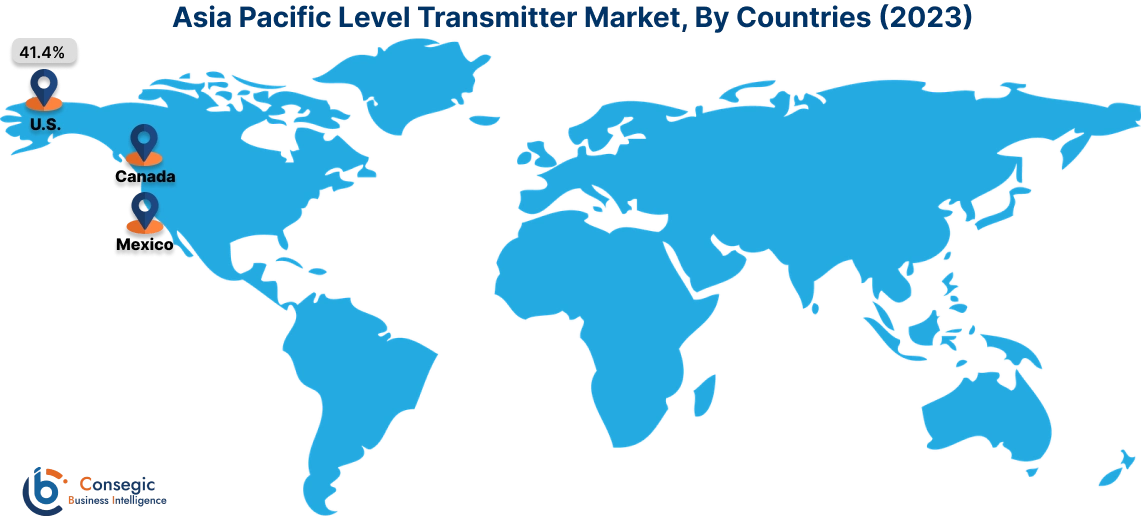
North America is estimated to reach over USD 1,409.31 Million by 2031 from a value of USD 1,083.20 Million in 2023 and is projected to grow by USD 1,100.63 Million in 2024. North America commands a significant share of the level transmitter market, primarily driven by the extensive adoption of industrial automation across key sectors such as oil & gas, water & wastewater, and chemicals. The United States leads the market with increasing demand for accurate and reliable level measurement systems to optimize operational efficiency in industries like petrochemical refining and food & beverages manufacturing. As per the market trends, the push towards environmental sustainability and safety compliance, particularly in chemical and energy production facilities, has driven investments in advanced-level transmitters with features such as real-time monitoring and corrosion resistance.
Europe represents a significant portion of the global market, with countries like Germany, France, and the United Kingdom leading in terms of adoption and innovation. The region benefits from a well-established industrial base and a strong emphasis on safety and environmental regulations. The UK's thriving chemical and pharmaceutical sectors add to the global demand for level transmitters, which play a crucial role in ensuring profitability and safety in industrial processes by delivering consistent and precise level measurements.
The Middle East & Africa region shows promising potential in the level transmitter market, particularly in countries like Saudi Arabia, the United Arab Emirates, and South Africa. Increasing investments in the oil and gas sector and the enlargement of the chemical industry are driving the need for level transmitters. As per market trends, the focus on diversifying economies and reducing dependence on oil revenues has led to development in the industrial sector.
Latin America is an emerging market for level transmitters, with Brazil and Mexico being the primary growth drivers. The rising adoption of industrial automation, improving infrastructure, and increasing focus on enhancing process efficiency contribute to the market’s enlargement. As per market trends, government initiatives aimed at modernizing industries and promoting economic development are supporting market progress.
Top Key Players & Market Share Insights:
The level transmitter market is highly competitive with major players providing products and services to the national and international markets. Key players are adopting several strategies in research and development (R&D), product innovation, and end-user launches to hold a strong position in the global level transmitter market. Key players in the level transmitter industry include -
- Siemens AG (Germany)
- Emerson Electric Co. (USA)
- Endress+Hauser Management AG (Switzerland)
- ABB Limited (Switzerland)
- Honeywell International Inc. (USA)
- Yokogawa Electric Corporation (Japan)
- VEGA Grieshaber KG (Germany)
- KROHNE Messtechnik GmbH (Germany)
- Schneider Electric SE (France)
- SICK AG (Germany)
Recent Industry Developments :
Product Launches:
- In July 2024, KROHNE launched the Optiwave 15xx series, featuring 80 GHz radar technology with HART and Bluetooth capabilities, designed for basic applications at a competitive price. This new radar offers reliable level measurement for a variety of industries, including chemical, food and beverage, and water treatment. The Optiwave 15xx series delivers high accuracy and performance, even in challenging conditions, while providing the convenience of Bluetooth for easy configuration and diagnostics via mobile devices. This affordable solution makes advanced radar technology accessible for a wide range of applications.
- In June 2023, KROHNE launched the BM26A 8000, its series of magnetic level indicators. This new product offers reliable, precise level measurement for industrial processes. The BM26A 8000 is designed for use in demanding applications, providing high levels of safety and performance. It features a modular design, making it adaptable to different process conditions. The magnetic level indicator is ideal for industries like oil and gas, chemicals, and power generation, ensuring optimal measurement accuracy and long-term durability.
- In January 2023, Emerson introduced the Rosemount 3408 Level Transmitter, a solution designed for accurate and reliable level measurement in industrial applications. This transmitter offers a compact design, easy installation, and improved measurement accuracy for both liquids and solids. It leverages guided wave radar technology, ensuring high performance even in challenging process conditions, such as varying temperatures, pressure, and material types. The Rosemount 3408 is ideal for industries like chemicals, oil and gas, and food processing, helping to improve operational efficiency and minimize downtime.
Level Transmitter Market Report Insights :
| Report Attributes | Report Details |
| Study Timeline | 2018-2031 |
| Market Size in 2031 | USD 4,283.63 Million |
| CAGR (2024-2031) | 3.5% |
| By Type |
|
| By Technology |
|
| By Mounting Type |
|
| By End-User Industry |
|
| By Region |
|
| Key Players |
|
| North America | U.S. Canada Mexico |
| Europe | U.K. Germany France Spain Italy Russia Benelux Rest of Europe |
| APAC | China South Korea Japan India Australia ASEAN Rest of Asia-Pacific |
| Middle East and Africa | GCC Turkey South Africa Rest of MEA |
| LATAM | Brazil Argentina Chile Rest of LATAM |
| Report Coverage |
|
Key Questions Answered in the Report
How big is the Level Transmitter Market? +
Level Transmitter Market size is estimated to reach over USD 4,283.63 Million by 2031 from a value of USD 3,258.80 Million in 2023 and is projected to grow by USD 3,314.70 Million in 2024, growing at a CAGR of 3.5% from 2024 to 2031.
What specific segmentation details are covered in the Level Transmitter Market report? +
The Level Transmitter Market report includes segmentation details for type (Capacitive Level Transmitter, Radar Level Transmitter, Ultrasonic Level Transmitter, Differential Pressure Level Transmitter, Magnetostrictive Level Transmitter, Guided Wave Radar Transmitter), technology (Contact, Non-Contact), mounting type (In-Tank, External, Inline), end-user industry (Oil & Gas, Chemicals, Water & Wastewater, Energy & Power, Food & Beverage, Pharmaceuticals), and region (Asia-Pacific, Europe, North America, Latin America, Middle East & Africa).
Which is the fastest-growing segment in the Level Transmitter Market? +
The Ultrasonic Level Transmitter segment is expected to register the fastest CAGR during the forecast period due to its increasing adoption in water management and the need for precise fluid level monitoring.
Who are the major players in the Level Transmitter Market? +
The major players in the Level Transmitter Market include Siemens AG (Germany), Emerson Electric Co. (USA), Endress+Hauser Management AG (Switzerland), ABB Limited (Switzerland), Honeywell International Inc. (USA), Yokogawa Electric Corporation (Japan), VEGA Grieshaber KG (Germany), KROHNE Messtechnik GmbH (Germany), Schneider Electric SE (France), and SICK AG (Germany).
